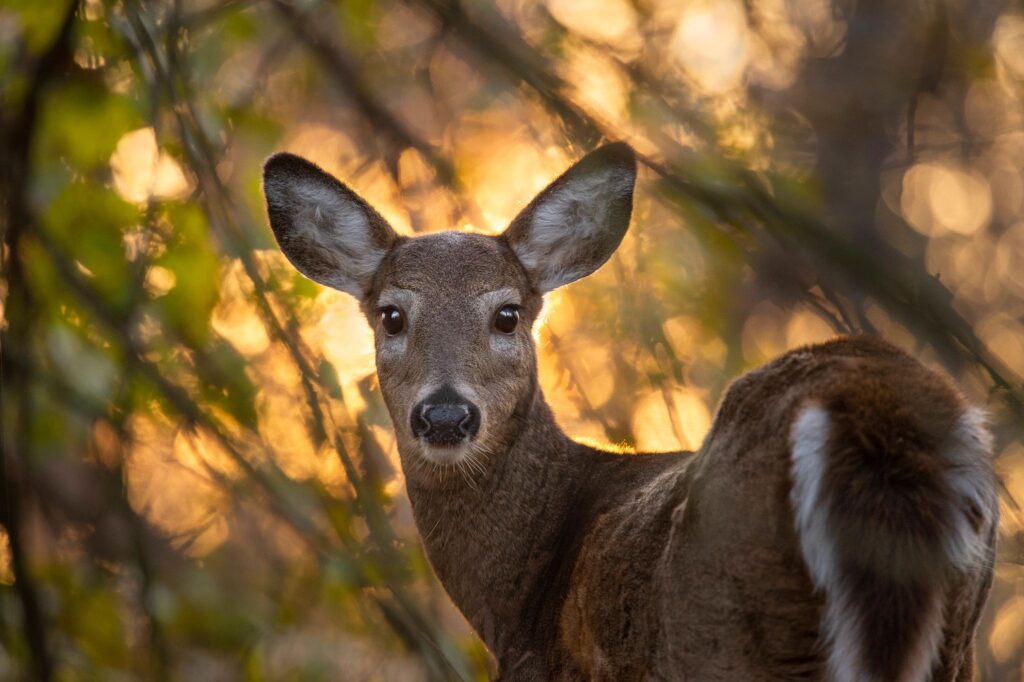 Urban Wildlife Damage Abatement and Control grants help urban areas develop wildlife plans, implement specific damage abatement and/or control measures for white-tailed deer and/or Canada geese. They are available to any town, city, village, county or tribal government with a population density of not less than 125 persons per square mile. This grant provides a 50% cost share up to $5,000 for eligible costs. The application deadline is Dec. 1.
Urban Wildlife Damage Abatement and Control grants help urban areas develop wildlife plans, implement specific damage abatement and/or control measures for white-tailed deer and/or Canada geese. They are available to any town, city, village, county or tribal government with a population density of not less than 125 persons per square mile. This grant provides a 50% cost share up to $5,000 for eligible costs. The application deadline is Dec. 1.
DNR Tree And Shrub Seedling Sales To Begin Oct. 6
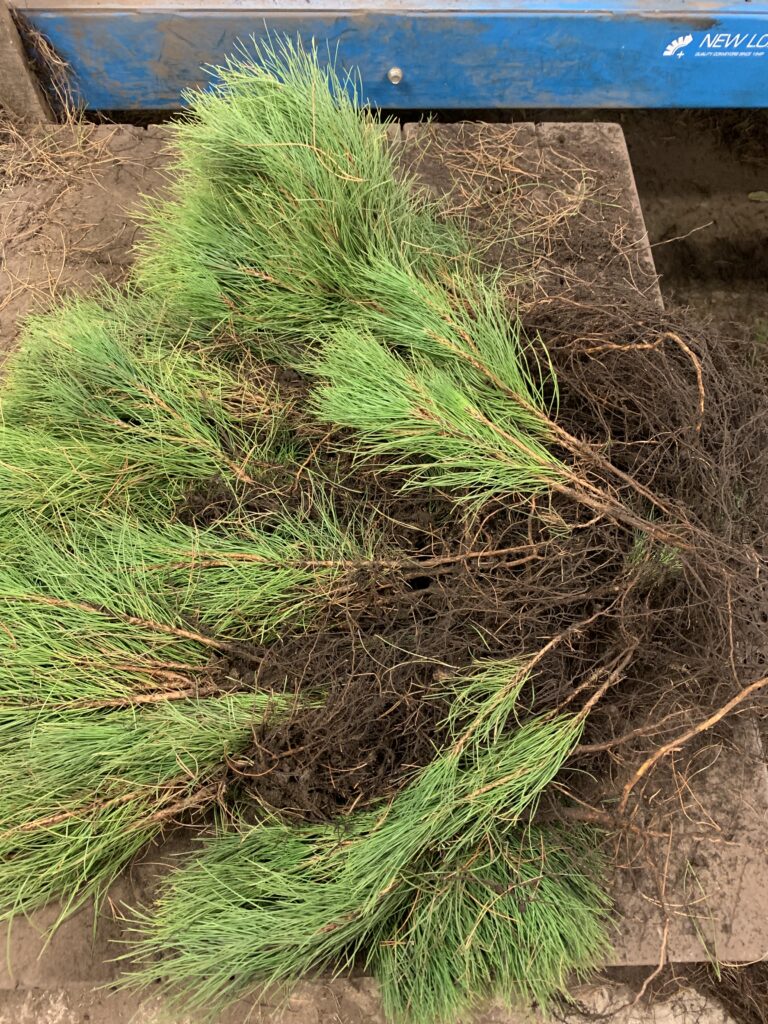 The Wisconsin Department of Natural Resources (DNR) is accepting seedling orders from Wisconsin landowners for trees and shrubs to be planted in spring 2026, starting Oct. 6, 2025.
The Wisconsin Department of Natural Resources (DNR) is accepting seedling orders from Wisconsin landowners for trees and shrubs to be planted in spring 2026, starting Oct. 6, 2025.
Wisconsin forest nurseries have provided high-quality, native tree seedlings, appropriate for planting throughout Wisconsin, for over 100 years. Seedlings grown at the state nurseries are used for reforestation and conservation plantings on private, industrial, tribal and public lands. Continue reading “DNR Tree And Shrub Seedling Sales To Begin Oct. 6”
Upcoming Trainings
 *These training opportunities are provided as an information service only and do not constitute an endorsement from the Wisconsin Department of Natural Resources (DNR).
*These training opportunities are provided as an information service only and do not constitute an endorsement from the Wisconsin Department of Natural Resources (DNR).
See below for information on training topics and events, including tree management and planning, urban tree diversity, root pruning, invasive species, urban wood, evergreen diseases, EHAP, the TRAQ program and fall foliage. Continue reading “Upcoming Trainings”
Keep It Local When Stocking Up On Firewood For Winter
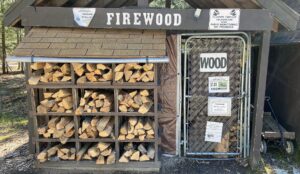
A stand at Potawatomi State Park offers local firewood for sale to campers. / Photo Credit: Wisconsin DNR
By Wisconsin DNR
With the onset of autumn, many Wisconsinites have been making plans to stock up on firewood for the winter.
With that in mind, the Wisconsin Department of Natural Resources (DNR) is reminding residents and visitors about the year-round importance of obtaining firewood from local sources — whether it’s to heat your home in the winter or build a campfire in the summer.
The message is important enough that October has been designated National Firewood Month, and the DNR offers a webpage to explain firewood regulations, best practices and the reasons behind those guidelines.
Continue reading “Keep It Local When Stocking Up On Firewood For Winter”
Beech Blight Aphids Visible In Eastern Wisconsin
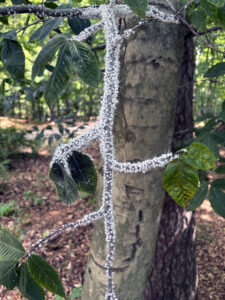
Beech blight aphids are found on a beech twig at Kohler-Andrae State Park in Sheboygan County, Sept 5, 2025. / Photo Credit: Wisconsin DNR
By Bill McNee, DNR Forest Health Specialist, Oshkosh
Bill.McnNe@wisconsin.gov
Late summer and fall is the time of year when fluffy “beech blight aphids” become very noticeable on American beech trees (Fagus grandifolia) in the eastern quarter of Wisconsin, where the tree species occurs.
These large aphids grow white, waxy filaments from their abdomens and feed in a colony on the branches of beech trees. When disturbed, they all shake their abdomens in an attempt to scare off predators. This behavior has led to the insect being commonly known as the “boogie woogie aphid.”
Continue reading “Beech Blight Aphids Visible In Eastern Wisconsin”
Cottony Ash Psyllid Found In Additional Areas
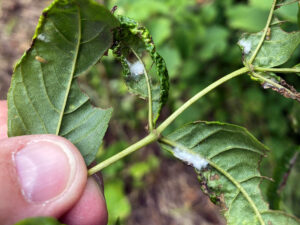
Cottony ash psyllid nymphs feed on the lower sides of leaves and grow white wool over themselves for protection. / Photo Credit: Wisconsin DNR
By Linda Williams, DNR Forest Health Specialist, Woodruff
Linda.Williams@wisconsin.gov, 920-360-0665
Cottony ash psyllid (Psyllopsis discrepans) was observed in 2023 in several areas in northern Wisconsin. Additional sites were then identified in 2024 and this year.
Some provinces in Canada have observed that psyllid numbers can explode during dry periods, so that may be why we started to see some issues in Wisconsin in 2023.
Continue reading “Cottony Ash Psyllid Found In Additional Areas”
Hail Damage Can Cause Dieback, Whole-Tree Mortality
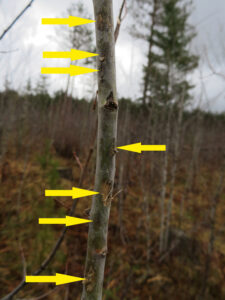
A young aspen shows signs of severe impact from hail. Arrows indicate each point of impact. / Photo Credit: Wisconsin DNR
By Linda Williams, DNR Forest Health Specialist, Woodruff
Linda.Williams@wisconsin.gov, 920-360-0665
Several high-impact storms across the state this summer have pummeled trees with hail. The photos accompanying this article show the kind of damage hail can bring to forests.
The initial damage following a significant hailstorm can immediately appear severe. But give it a month or two, and the damage can look even more pronounced.
Pines in particular will start to turn varying levels of brown, depending on the amount of damage they sustained. Damage to the branches and twigs is not limited to just the spot where the hail hit. As the summer goes on, damaged areas of bark that were cracked by the hail impact will often split open further and allow more drying and additional separation of the bark from the wood, which kills that area of the branch.
Continue reading “Hail Damage Can Cause Dieback, Whole-Tree Mortality”
Bur Oak Blight Confirmed In Calumet County
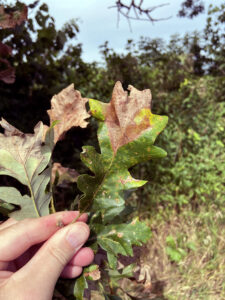
A wedge-shaped area of dead tissue at the tip of a bur oak leaf from a tree infected with bur oak blight. / Photo Credit: Wisconsin DNR
By Bill McNee, DNR Forest Health Specialist, Oshkosh
Bill.McNee@wisconsin.gov
Recent laboratory examination has confirmed the presence of bur oak blight in Calumet County. The disease affects only bur oaks and is caused by the fungus, Tubakia iowensis.
Calumet County is the 35th Wisconsin county to have a confirmed detection of bur oak blight. The disease has not been microscopically confirmed in all counties where bur oak grows and is likely present in additional counties. Bur oak blight was first reported in Midwestern states in the 1990s.
Continue reading “Bur Oak Blight Confirmed In Calumet County”
HRD Conks Found In Different Shapes And Sizes
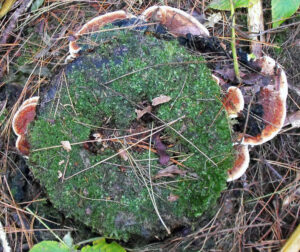
Heterobasidion root disease grows from an infected tree stump. / Photo Credit: Wisconsin DNR
By Kyoko Scanlon, DNR Forest Pathologist, Fitchburg
Kyoko.Scanlon@wisconsin.gov
Fall is a great time to look for mushrooms, including conks from trees infested with Heterobasidion root disease (HRD).
Considered one of the most destructive diseases of conifers in the northern hemisphere, the fungus causing HRD is very difficult to eradicate once established. Infestation of a conifer stand may significantly impact stand management, making early detection of the disease extremely important.
Continue reading “HRD Conks Found In Different Shapes And Sizes”
Fall Webworm Spins Its Way To Attention
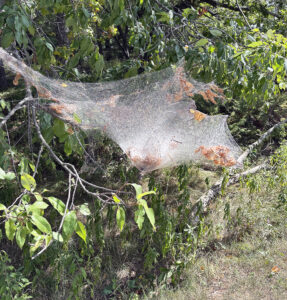
Fall webworms form a tent on a tree at Kohler-Andrae State Park in September 2025. / Photo Credit: Wisconsin DNR
By Bill McNee, DNR Forest Health specialist, Oshkosh
Bill.McNee@wisconsin.gov, 920-360-0942
The native insect known as fall webworm (Hyphantria cunea) has been generating calls and emails from curious property owners over the past few weeks.
The caterpillars don’t draw much attention on their own; instead, what catches the eye at this time of year are the large webs (or “tents”) that they create on the tips of tree branches.
